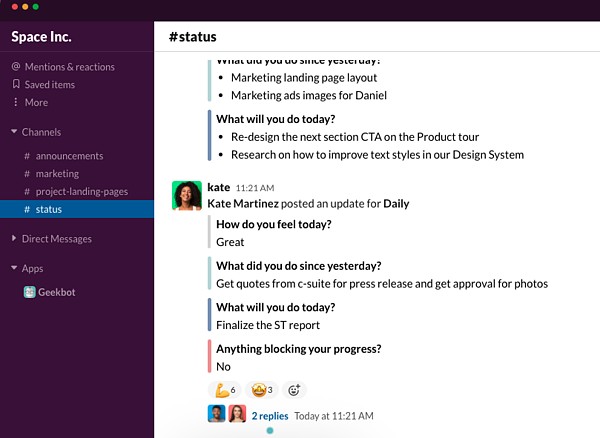According to Microsoft’s 2022 Annual Work Trend Index Report, 53% of employees are considering transitioning to a hybrid work setup in the next year and hybrid work is up seven points from 2021.
So, what does it take to lead a hybrid team? We’ve got a few tips.
1. Set rules of engagement.
When everyone’s in the office, many rules and behaviors go unsaid. After all, everyone is in the same space, so it’s easier to pick up on cues. However, when everyone is scattered, it changes how you approach them.
Microsoft’s report found that following the pandemic, few companies (only 28%) have met with their teams to define their new normal since switching to a hybrid or remote model.
This can lead to confusion, unmet expectations, and high attrition rates. Setting a structure around communication and collaboration allows the team to work more efficiently as it promotes cohesion among all members, despite the physical distance.
2. Leverage asynchronous communication.
Speaking of distance, it can be nearly impossible to get everyone on a call at the same time depending on where your team is.
For instance, say you have some team members in California, others in New York, and some overseas in Kenya. Those are three time zones, meaning three different work schedules.
One way to keep your team connected is to leverage asynchronous tools.
For instance, you can utilize bots within your messaging system, whether it’s Slack, Teams, or another platform, to invite your team to share updates, check-ins, etc.

With Geekbot, the software can be programmed to ask your team specific questions, then share their answers.
So, if your team is unable to sync up for daily meetings, you can still get progress updates from everyone in a channel of your choosing.
3. Have a robust onboarding process.
Having a strong onboarding process is more important than ever.
Data from the Microsoft report shows that employees onboarded during the last two years are at greater risk for attrition, are less likely to feel included within their teams, and tend to have weaker relationships with their direct teams.
Since the pandemic, new hires are relying more on their managers for onboarding – and that’s a good thing for the company.
The study found that new hires whose managers played an active role in their onboarding process were 3.5 times more likely to be satisfied with their experience.
Here are some tips to optimize your onboarding process:
- Prepare training materials and create an onboarding guide.
- Launch an internal mentorship program to guide new hires within the first few months.
- Have a welcome chat to introduce the new hire to the team.
- Send your new hire a survey about their onboarding experience to assess gaps in the process.
4. Trust your team.
Trust is the number one component of a successful hybrid or remote team. Without it, neither party is able to successfully respond to their responsibilities.
In the office, you can always keep an eye on your team. Walking by their desk to check in on a project, peeking to see if they’re actively working. When your team is hybrid, you lose that level of visibility.
As such, you’re forced to trust your team. How do you build trust? Well, it’s a two-way street and it starts with you.
Firstly, be transparent. This encompasses everything from sharing feedback on performance to sharing resources to sharing team and company-wide updates.
Secondly, create a space where your team feels psychologically safe – safe to share ideas, be themselves, learn, and challenge the status quo.
Lastly, find out what matters to each person on your team. What do they value? What are their goals? How do they like to be celebrated? How do they learn best?
Trust also extends to their work. Even though 80% of employees say they are just as productive since going hybrid or remote, most leaders (54%) fear productivity has or will negatively impact their teams, according to the Microsoft report.
Avoid the temptation to micromanage your team. Instead, set the parameters for their tasks, check in with their progress, provide resources when needed, and offer feedback. This will empower your team to do their best work knowing that they have the full support and trust of their manager.
5. Prioritize team culture.
According to the 2022 Microsoft report, the top aspect of work employees views as important – other than money – is a positive culture.
Even though your team is hybrid, you still have to work hard to build its culture. If anything, it’s even more important since you don’t have the physical environment to rely on.
When you have a hybrid team, you have to be intentional about everything – particularly connecting on a non-work level.
43% of leaders surveyed in the Microsoft report say relationship-building is the number one challenge in remote and hybrid work.
After all, you can’t just invite your team to a happy hour at a local restaurant or have an impromptu group lunch.
What you want to avoid is an imbalance where some members feel disconnected from the team because of their distance, which is pretty common. In fact, 44% of hybrid employees surveyed said they do not feel included in meetings.
Here are a few ways to make sure your team feels connected:
- Host virtual events, such as escape rooms, magic shows, and cooking classes, that your team can enjoy as a group.
- Have regular "watercooler" meetings that allow your team to gather and talk about anything non-work related.
- Create non-work-related messaging channels based on your team’s interests, like cooking, TV shows, home renovation projects, pets, etc.
- Plan annual or quarterly meetups with your team, if your budget allows.
This is your opportunity to shape it into one that fosters inclusion, collaboration, and trust.
6. Invest in your team’s equipment.
When your team works in an office, there are certain things you don’t need to account for, such as Wi-Fi, computer, headset, desk, etc.
However, if you have some people from your team working from home, they will need to have access to the same equipment to succeed in their role.
There are also nice-to-have items that aren’t needed to complete the job but can make your team happier and more productive. Think headphones and ergonomic equipment.
Instead of seeing it as an additional expense, consider it an investment into your team that will pay off tenfold.
There you have it – whether your team is newly hybrid or has always been, there’s always room for improvement. With these tips, your team will work as seamlessly as you would in person.

